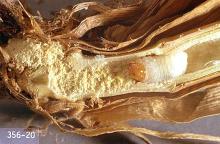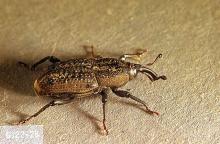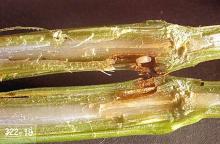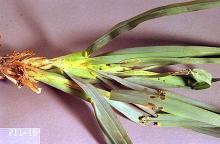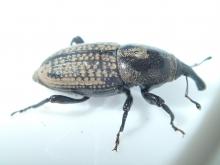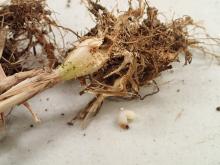Bluegrass billbug (Sphenophorus parvulus)
Denver billbug (S. cicatristriatus)
Hunting billbug (S. venatus)
Phoenician billbug (S. phoeniciensis)
Pest description and crop damage Adults are about 0.375 inch in length, black, with a distinct snout. They lay eggs in late spring. Larvae are white with a brown head, no visible legs, and about 0.25 inch long when mature (much smaller than Japanese beetle and European chafer larvae). Larvae generally reach damaging size by midsummer. Larvae feed on grass roots. Damage often shows up as irregular patches of drought-stressed turf that is not anchored or rooted to the soil. Kentucky bluegrass and annual bluegrass is most commonly attacked by billbug larvae. However, tall fescue, perennial rye, and chewings fescue are also susceptible. Billbugs classically cause problems in eastern Oregon, central Washington and Idaho-especially around Ontario-Baker City and Boise-Twin Falls-and also occasionally from La Grande into the Columbia Gorge. More recently billbug damage has been observed in the Portland and Eugene, as well as the Seattle/Tacoma areas.
Biology and life history Bluegrass billbugs overwinter as adults. Eggs are laid on grass stems in May or June and hatch in about 2 weeks. As the larvae mature, they move from the crown of the plant into the soil where they feed on roots. There is one generation per year. The Denver and hunting billbugs have a similar life cycle but may lay eggs for a longer period resulting in larvae that overwinter in the soil. Damage from these species can occur much earlier in spring than damage from the bluegrass billbug. Perennial ryegrasses, fine fescues, and tall fescues with high levels of endophytic fungi are resistant to billbugs.
Scouting and action threshold Scouting for billbugs should begin in the early summer (June and July) before damage occurs in the summer months. Scout in the top 2 inches of the soil using a shovel. The action threshold for well-maintained turfgrass is 10 to 20 larvae per sq ft.
Management-biological control
- beneficial nematodes
Management-chemical control
Products for home use
- bifenthrin
- carbaryl
- chlorantraniliprole
- deltamethrin
- fenvalerate
- gamma-cyhalothrin
- imidacloprid-Some neonicotinoids have been banned from use on public properties.
- lambda-cyhalothrin
- permethrin
- plant essential oils (clove, mint, peppermint, etc.)-Some formulations are OMRI-listed for organic use.
Products for commercial use
- azadiractin-Some formulations are OMRI-listed for organic use.
- Beauvaria bassiana GHA-Some formulations are OMRI-listed for organic use.
- beta-cyfluthrin-Restricted use
- bifenthrin-Restricted use
- bifenthrin + imidacloprid-Restricted use
- chlorantraniliprole
- clothianidin-Some neonicotinoids have been banned from use on public properties.
- clothianidin + bifenthrin-Restricted use
- cyantraniliprole
- cyfluthrin
- deltamethrin-Restricted use
- dinotefuran-Some neonicotinoids have been banned from use on public properties.
- esfenvalerate + prallethrin + piperonyl butoxide-Restricted use
- imidacloprid-Some neonicotinoids have been banned from use on public properties.
- gamma-cyhalothrin
- lambda-cyhalothrin-Restricted use
- mint oil, geraniol + oil of rosemary-OMRI-listed for organic use.
- permethrin
- tetraniliprole
- thiamethoxam-Some neonicotinoids have been banned from use on public properties
- trichlorfon


